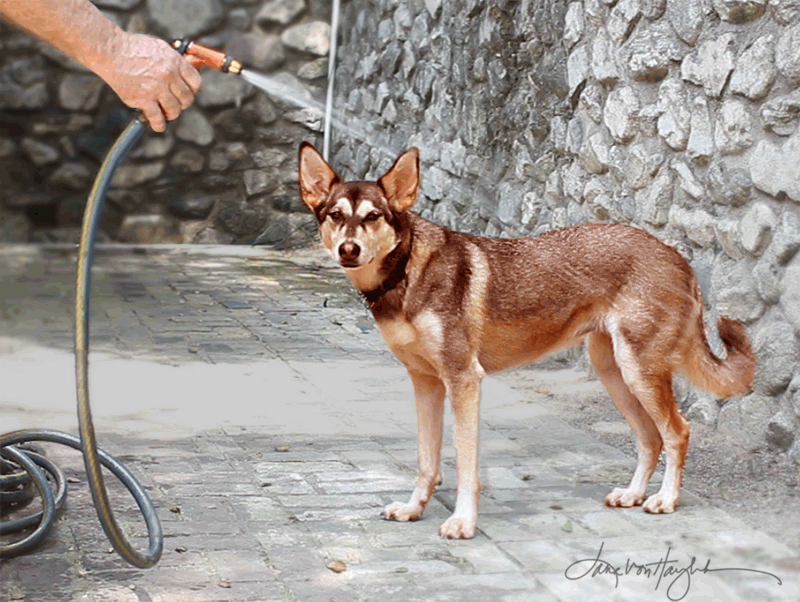
Both Dog and Humans at Risk…from drinking water!
Here comes summer and with it all the related safety hazards that need to be addressed to keep both you and your dog safe: watching out for broken glass while on walks, making sure you and your dog use canine-safe sunscreen, keeping off hot sand, pavement and asphalt, never leaving dogs alone in a car, always having plenty of fresh water available, waiting for the car seats to cool down before asking your dog to jump in, and so on.
But there’s one hazard most people are unaware of: hose water. I received a call last summer from a client whose Labrador retriever, Conner, was exhibiting all the signs of a dog needing immediate veterinary care: vomiting, diarrhea, low energy. I told her to take Conner to the vet immediately. The vet put Conner on an IV and she gave him a thorough examination including blood and fecal tests. Although many of the tests came back normal, the vet had experience with a summer hazard unfamiliar to many people: the hazardous chemicals that build up in garden hoses left out in the sun. I have had three such instances of dogs suffering from hazardous hose water over the years.
Patty Davis, a spokeswoman for the Consumer Product Safety Commission said, “the commission would never recommend that any consumer drink from a garden hose.” Because of the experience I’ve had over the years, neither should dogs. Ms. Davis: “The real health concern here is bacterial contamination,” she said. “Garden hoses sit outside and bake in the sun. Anything can get in them, and it’s a perfect environment for all sorts of microbial communities.”
When it comes to dogs, some, like my client’s dog Conner, are more sensitive to these same chemicals and bacteria than others.
It’s all in the hose.
In an article written by Joanna M. Foster that appeared in the New York Times on May 7, 2012, she reported on a study done by the Ecology Center, a nonprofit environmental organization based in Ann Arbor, Michigan that reviews consumer products for human use. She writes: “To illustrate how chemicals can migrate from garden hoses into water, the research team left a section of garden hose filled with water out in the sun over multiple days. When the water was tested it was found to exceed federal standards for safe drinking water for several chemicals — including four times the standard considered safe for phthalates, 18 times that for lead and 20 times that for BPA.
What are the hazards of phthalates?
According to studies reported on HealthyStuff.org, a website created by The Ecology Center:
“Phthalates are a group of chemicals, some of which have endocrine-disrupting properties, that can disturb normal hormonal processes, often at low levels of exposure. (Illinois EPA 2000).
- Exposure to phthalates is linked to birth defects of the genitals and altered levels of reproductive hormones in baby boys. An increased breast cancer risk is also suspected (Main 2006, Swan 2005, Marsee 2006). Phthalates in building products have also been linked to asthma. (Mendell, 2007).
- Human testing by the federal government finds phthalates in almost all of the population, with the highest levels in children ages 6 to 11 years and in women (CDC, 2005). DINP (one type of phthalate) is commonly used as an additive in children’s toys.
- Studies have demonstrated possible links between DINP and adverse impacts on the reproductive system, kidneys, liver, and blood (State of Oregon, PDF). In vitro maternal exposure to DEHP has been correlated to improper brain development in fetal rats. (Xu 2007).
In the April, 2008 edition of the Whole Dog Journal, author Susan Weinstein wrote an article entitled, The Dangers of Vinyl Dog Toys. She reported:
“In 2006, the Danish Ministry of the Environment (MoE) published a report entitled (in the English translation)…’findings about the dangers of phthalates, drawn from studies carried out on rats, should be seen as significant not only for humans but also for dogs and cats.’ ”
What about lead contamination?
Obviously if hoses have lead in them, both dogs and humans should avoid drinking water from them. But here’s the rub: because the lead build up reported in the studies was associated with brass fittings, aka the hose nozzle, the hose could no longer be considered “drink safe!’
For dogs, anything above 0.25 ppm (or 25 mcg/dl) is considered to be consistent with lead poisoning. In the tests reported by The Ecology Center’s Healthystuuf.org, the amounts of lead from the garden hose was .28 ppm.
When I learned about the lead contamination in hoses, it made sense to me to only use lead-free, drink-safe hoses, not only for my dogs, but I didn’t want to water my garden vegetables with them either.
Safety tips:
- Buy hoses labeled “lead free, drink safe.”
- Avoid hoses with PVC and vinyl (as well as vinyl toys!)
- Flush your hoses so that there’s no water left inside.
- Never leave a hose in the sun.
Lastly, please exercise caution. If you’ve forgotten and left even your drink-safe hose out in the sun, the water left in the hose can get scalding hot. If you have a dog that likes playing with the water spray as many of dogs do, make sure the water has cooled beforehand.

Hi Paul,
Thank you so much for the information. As a dog trainer certified in pet first aid by the American Red Cross in 2008, that is one of the situations that we’re not often taught to avoid. I hope everyon reads this post.
Thanks, Paul. This is something that people just don’t think about. Our animal friends don’t need to ingest chemical, toxic soup. I’ve put this on my FB page to reach even more people, referenced back to you of course.
Love what you do!
Sue
http://www.facebook.com/suebecker.animalcommunicator
Hello Paul
Good info to know! Thank you for sharing!